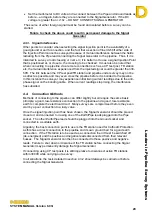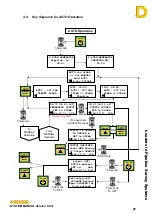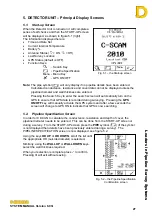
Leaders in Pipelin
e Survey Systems
C
C
C
-
-
-
S
S
S
C
C
C
A
A
A
N
N
N
2
2
2
0
0
0
1
1
1
0
0
0
SYSTEM MANUAL Version 6.03i
31
6. DETECTOR UNIT – Field Operations
6.1. Operating Environment
The Detector is housed in a strong weather proof case, but is still a precision measuring
instrument and should be treated as such. It is weatherproof to IP65 with total immersion
up to a maximum of 1ft 7” and is resistant to oils and alkalines.
6.2.
Survey
Principles
The various types of survey and the general procedure for completing a survey are
outlined below. These concentrate on coating evaluation surveys and will need to be
adapted for unique surveys such as depth of cover surveys, although the principles remain
the same.
6.2.1. Survey Type
When using C-SCAN to survey a pipeline for the first time, Dynalog recommends the
following as a survey method:
Baseline Survey
(Initial Survey)
The first survey carried out needs to build a baseline data profile
of the pipeline. In this instance it is recommended to take
survey readings approximately every 300ft to build a complete
picture of the pipeline, in both current (attenuation) and depth
profiles. Any areas which produce high attenuation values can
be analysed and repaired where necessary. (Attenuation values
are discussed in section 7.2)
Periodic Survey
(Subsequent Surveys)
For subsequent surveys, readings can be taken at much larger
intervals as C-SCAN’s ability to produce absolute results means
that these readings can be directly compared to the baseline
survey or any previous C-SCAN survey data. This means that
subsequent surveys can be carried out quickly to confirm that
little or no change in attenuation levels has occurred, and only
areas that show a marked increase in attenuation readings need
further investigation.
Closer Inspection
For areas that require closer inspection, the ‘halving’ method
can be used to isolate the small section of pipeline that is
producing high attenuation readings, or to confirm if a larger
area has general coating degradation. This principle is
explained in more detail in section 6.8.
Fault Location
(Close Interval Survey)
After the ‘halving’ method has been used to isolate the short
section (100-150ft typical) of pipeline in which the anomaly
exists, the CLOSE INTERVAL mode in C-SCAN can be used to
identify the anomaly (location and extent) for later action as
necessary.
















































